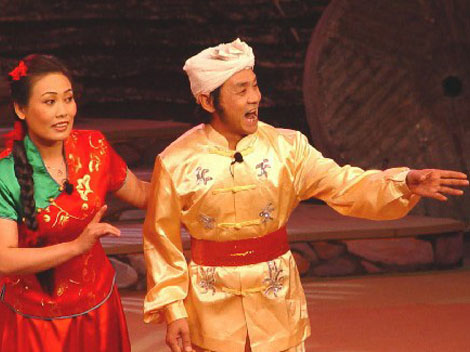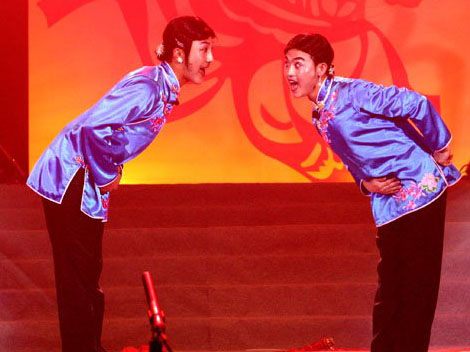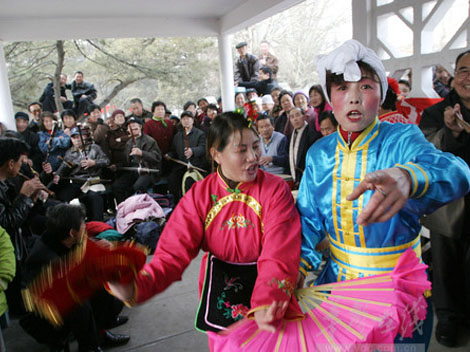
Song-and-dance Duet, or "Song-and-dance Squad", is a genre of opera prevailing in Inner Mongolia Autonomous Region and northern regions of Shanxi, Shaanxi and Hebei Province. The repertoires are usually sung by one clown and one positive female role, hence comes the name. Different artistic styles of Song-and-dance Duet have been gradually formed in different regions during the long-term development. It was divided into East School and West School, with Hohhot (capital of Inner Mongolia) as the separatrix.

There are two versions as to when and where Song-and-dance Duet was formed. The first version is that it was originated during Guangxu Reigning Period of the Qing Dynasty (1875-1908) in Tumoteqi region in the west of Inner Mongolia. A clown and a positive female role were created on the basis of folk songs of the Mongolian and Han Nationality as well as the tone of Quyi (Chinese folk art forms) and silk strings, in combination with dance of the Han Nationality in folk art performance given on traditional or religious festivals. Featuring singing and dance, it is called "Mongolian Music". The second version is that it was evolved from the tone of Quyi combined with dancing motions of Yangko (i.e. "Kicking thigh") during Xianfeng and Tongzhi Reigning Period of the Qing Dynasty (1851-1874). Song-and-dance Duet was originally a form of make-up recreational performance of farmers in their off-labor time. In the late Qing Dynasty and early Min Dynasty, occupational troupes came into existence in Tumote region in Inner Mongolia. Each troupe consisted of five to seven players. As time elapsed, the number of repertoires grew gradually, and the performance was increasingly perfected, with this genre of opera evolving from performance and singing to character representation folk playlet.

Performance of Song-and-dance Duet was fairly unitary at the initial stage. There were only two roles in it: one clown and one positive female role. The costume was very simple; the prop was limited to handkerchief, folding fan and overlord's whip. Moreover, the musical instruments used in it merely included flute, four-string fiddle, dulcimer and four-tile (slit drum). What the performers sang were usually ditties themed with the five watches of the night, four seasons and twelve months, such as Red Cloud, Ten Segments of Brocade and Ten Pairs of Flowers. With its dancing gestures similar to those of Yangko, Song-and-dance Duet was usually sung in the third person, featuring simple scenario and deficiency of vivid character image.
Along with the spread of Song-and-dance Duet, this genre of opera was reformed by actors in performance. It was commonly adapted from folk songs. For example, the repertoire Migrating West was originally performed with antiphonal singing in the second person and was later performed in the first person after it was adapted, becoming a playlet with scenario and characters being added. As for aria, the original exclusive performance of a singular melody was evolved into combined use of multiple melodies. Meanwhile, aria was changed in soundboards such as high tone, slow soundboard, flowing soundboard and quick soundboard (Niezi Soundboard). As per the content of different repertoires, the performance was broken down into such forms as singing and dancing "Fiery Melody" (or "Playlet with Whips") and "Yingma Playlet" which was focused on the art of singing and acting.
The current Song-and-dance Duet is classified into three categories: "Yingma Playlet", "Fiery Melody" (or "Playlet with Whips") and antiphonal singing. "Yingma Playlet" is focused on singing, recital and motion. It gives prominence to performing effect and requires fairly good voice of performers. Repertoires of it include Migrating West and Visiting the Sick. In contrast, "Fiery Melody" is featured by simultaneous singing and dancing. The repertoires include Hanging Red Lanterns and Beating Coins Ducats, which are usually themed with farmers' life and love stories. Antiphonal singing is characterized by the singing of two performers by turns.





